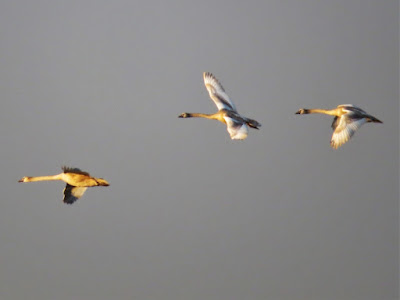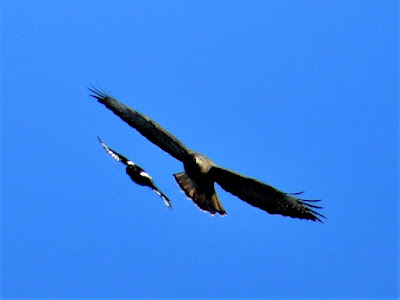5.0°C > 8.0°C: Clearing after overnight light rain with good sunny spells. Initially fresh NW wind moderated quickly. Excellent visibility.
Sunrise: 07:46 BST
*= a photo today
Priorslee Lake: 06:10 – 09:30
(236th visit of the year)
Highlight this morning was a calling Cetti's Warbler along the N side. Giving acceptable views as it worked along the lakeside vegetation at 07:50. Too dark to attempt a photo at that time. When I revisited the area after 09:00 I could not relocate it. My previous record here was of a bird singing and calling in early October last year. My only other record here was of presumably one bird that stayed from late October 2015 until May 2016. It become bird species #110 for me here this year – a total that exceeds that of any previous year for me
Also notable was a passage of at least 1650 Wood Pigeons. There were probably many more. They almost all passed between 08:15 and 09:15 and were often in concurrent large groups flying at different heights and in slightly different directions.
Bird notes:
- Two Canada Geese flew off at 07:00.
- The adult Mute Swans too the cygnets for a long flight, high over the Priorslee Estate and then across the M54 and over Stafford Park before they all returned. Probably getting ready to leave.
- No Gadwall seen.
- 20 brownhead Goosanders flew W at 08:10.
- One of the Great Crested Grebes was an immature.
- The early large gulls were in very short supply, with almost as many flying over from the E as arriving from the usual N / NW direction. Just six settled on the lake at this time.
- A Grey Heron flew off W at 07:30. It, or another, flew off E at 08:45.
- Three parties of Siskins overhead, one of 17 birds.
Overhead:
- 3 Greylag Geese: single and duo outbound
- 2 (1♂) Mallard
- 20 Goosanders: all brownheads, together
- 1 Stock Dove
- 1700+ Wood Pigeons: at least 1650 of these in 33 groups heading S
- 1 Herring Gull
- 29 Lesser Black-backed Gulls
- 19 unidentified large gulls: see notes
- 2 Common Buzzards
- 195 Jackdaws
- 15 Rooks
- 6 Skylarks
- 8 Starlings: two groups
- 15 Pied Wagtails
- 1 Meadow Pipit
- 1 Linnet
- 22 Siskins
Warbler noted:
- 1 Cetti's Warbler: as highlighted
- 1 Chiffchaff: still calling intermittently
Birds noted leaving roosts around the lake:
- 7 Starlings
- 4 Redwings
- 9 Reed Buntings
Count from the lake area:
- 2 Canada Geese again: departed
- 2 + 3 (1 brood) Mute Swans
- no Gadwall
- 7 (5♂) Mallard
- 31 (>14♂) Tufted Duck
- 6 Moorhens
- 52 Coots only
- 1 Little Grebe
- 3 Great Crested Grebes
- c.125 Black-headed Gulls
- 3 Herring Gulls
- 12 Lesser Black-backed Gulls
- 6 unidentified large gulls only: see notes
- 1 or 2 Grey Herons: flew off
At / around the street lamps pre-dawn:
Moths:
- 1 November Moth agg. (Epirrita sp.).
with:
- 1 Pond Olive mayfly (Cloeon dipterum)
- 1 Larinioides cornutus Orb-web spider
- 1 Bridge Orb-web Spiders (Larinioides sclopetarius)
- 1 Paroligolophus agrestis harvestman
- 1 Anyphaena accentuta
Noted later:
- Grey Squirrel
Not a very good photo: top right an immature Great Crested Grebe and in the foreground two duck Tufted Ducks. I have seen no juvenile Great Crested Grebes here since 26th September.
This is a male mayfly, presumably a Pond Olive (Cloeon dipterum). As a male it has 'turbinate' eyes, thought to be an aid to spotting females in a swarm. No swarms here. This was on a different lamp pole to the female seen a few days ago.
Aargh! This is the exoskeleton of an Araneid spider: species indeterminate. Having out-grown its 'skin' it has climbed out and the real spider will be hiding somewhere while its new skin hardens.
Noted later:
- Grey Squirrel
The three cygnets in flight, now with much white in the wings. If the previous years are anything to go by the parents will soon take them away from home and show them elsewhere. In 2019 the cygnets stayed away. In 2020 they all retuned and the cygnets were finally chased away in February this year.
Not a very good photo: top right an immature Great Crested Grebe and in the foreground two duck Tufted Ducks. I have seen no juvenile Great Crested Grebes here since 26th September.
This is a male mayfly, presumably a Pond Olive (Cloeon dipterum). As a male it has 'turbinate' eyes, thought to be an aid to spotting females in a swarm. No swarms here. This was on a different lamp pole to the female seen a few days ago.
Aargh! This is the exoskeleton of an Araneid spider: species indeterminate. Having out-grown its 'skin' it has climbed out and the real spider will be hiding somewhere while its new skin hardens.
Info from the ever-helpful Nigel about yet another different-looking spider: this is a female buzzing spider (Anyphaena accentuta). It is called the buzzing spider because the male rapidly taps his abdomen up and down on a leaf producing a slow buzzing sound to attract a female.
A common-enough harvestman but this individual was sitting such that the identification features were clearly visible. On this species the second pair of legs is noticeably long – all harvestmen have the second leg the longest but this is especially so with this species. All the legs are noticeably thicker on the basal part. And there is a pale stripe down the middle of the abdomen.
(Ed Wilson)
(Ed Wilson)
------------------------------------------------------------------------------------------------------
The Flash: 09:35 – 10:35
(213th visit of the year)
Bird notes:
- Little Grebe not located.
- Again only two of the juvenile Great Crested Grebes noted.
Birds noted flying over here:
- 11 Wood Pigeons
- 1 Lesser Black-backed Gull
- 1 Sparrowhawk
- 1 Common Buzzard
- 3 Skylarks
- 1 Jackdaw
Warblers note:
- 1 Chiffchaff: still calling persistently, today from the island
On /around the water:
- 29 Canada Geese
- 6 Greylag Geese
- 3 + 2 (1 brood) Mute Swan
- 28 (18♂) Mallard
- 43 (11+♂) Tufted Duck
- 26 (0♂) Goosander
- 10 Moorhens
- 24 Coots
- 3 + 2 (1 brood) Great Crested Grebes again
- 58 Black-headed Gulls
- 2 Grey Herons
On the lamp poles:
(213th visit of the year)
Bird notes:
- Little Grebe not located.
- Again only two of the juvenile Great Crested Grebes noted.
Birds noted flying over here:
- 11 Wood Pigeons
- 1 Lesser Black-backed Gull
- 1 Sparrowhawk
- 1 Common Buzzard
- 3 Skylarks
- 1 Jackdaw
Warblers note:
- 1 Chiffchaff: still calling persistently, today from the island
On /around the water:
- 29 Canada Geese
- 6 Greylag Geese
- 3 + 2 (1 brood) Mute Swan
- 28 (18♂) Mallard
- 43 (11+♂) Tufted Duck
- 26 (0♂) Goosander
- 10 Moorhens
- 24 Coots
- 3 + 2 (1 brood) Great Crested Grebes again
- 58 Black-headed Gulls
- 2 Grey Herons
On the lamp poles:
Nothing found on any of them
Noted elsewhere:
- Red Admiral (Vanessa atalanta)
- Common Wasp (Paravespula vulgaris) on the Ivy flowers.
- Marmalade Hoverfly (Episyrphus balteatus)
- Common Drone Fly (Eristalis tenax)
Noted elsewhere:
- Red Admiral (Vanessa atalanta)
- Common Wasp (Paravespula vulgaris) on the Ivy flowers.
- Marmalade Hoverfly (Episyrphus balteatus)
- Common Drone Fly (Eristalis tenax)
A short video of the flock of Goosanders bobbing up and down on the waves – you may need to take Kwells before viewing this clip (other sea-sick remedies...). It is Black-headed Gulls that were photo-bombing the clip.
Formation flying! A Magpie appears to be pursuing a Common Buzzard
Or is it? The buzzard seems to be chasing the Magpie!
Despite the ambient temperature being below 10°C – generally recognised as the threshold needed for insects to fly – there was much activity on the Ivy which was in the sun and somewhat sheltered from the brisk wind. This Red Admiral (Vanessa atalanta) was the only butterfly among all the wasps and hoverflies.
Another view. For some reason my camera seems to want to convert this species in to Orange Admirals.
This is a Marmalade Hoverfly (Episyrphus balteatus). Strangely it is my first here this year. The last one I saw at the lake was on 15th September. Where have they been between times?
The subject of this rather sharper photo is a Common Drone Fly (Eristalis tenax). It is just possible to make out its tongue stuck in to an Ivy flower.
(Ed Wilson)
Sightings from previous years without links are below
2010
Priorslee Lake
Little Grebe
5 Lapwings
1487 Fieldfare logged, mostly flying W. 7 of the flocks estimated at between 110 and 130 birds
25 Redwings
Raven
56 Goldfinch
(Ed Wilson)
2009
Priorslee Lake
62 Swans
5 Wigeon
14 Pochard
22 Tufted Ducks
231 Coots
Great Black-backed Gull
3 Buzzards
1 Kestrel
27 Redwings
Chiffchaff
c.250 Starlings
8 Siskins
c.15 Goldfinches
(Ed Wilson)
2006
Priorslee Lake
1 Cormorant
25 Pochard
72 Tufted Ducks
1 Kestrel
1 Kingfisher
20 Robins
17 Blackbirds
15 Song Thrushes
59 Redwing
3 Mistle Thrushes
1 Chiffchaff
1 Blackcap
5 Goldcrests
(Martin Adlam)
------------------------------------------------------------------------------------------------------
On this day can be found via the yearly links in the right-hand column.
2010
Priorslee Lake
Little Grebe
5 Lapwings
1487 Fieldfare logged, mostly flying W. 7 of the flocks estimated at between 110 and 130 birds
25 Redwings
Raven
56 Goldfinch
(Ed Wilson)
2009
Priorslee Lake
62 Swans
5 Wigeon
14 Pochard
22 Tufted Ducks
231 Coots
Great Black-backed Gull
3 Buzzards
1 Kestrel
27 Redwings
Chiffchaff
c.250 Starlings
8 Siskins
c.15 Goldfinches
(Ed Wilson)
2006
Priorslee Lake
1 Cormorant
25 Pochard
72 Tufted Ducks
1 Kestrel
1 Kingfisher
20 Robins
17 Blackbirds
15 Song Thrushes
59 Redwing
3 Mistle Thrushes
1 Chiffchaff
1 Blackcap
5 Goldcrests
(Martin Adlam)











